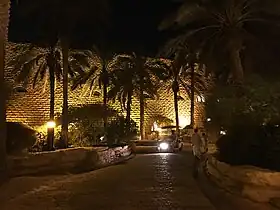Tuwaiq Palace
Tuwaiq Palace or Towaiq Palace is a building in the Alhattan Street of the Diplomatic Quarter district in Riyadh, Saudi Arabia, which hosts government functions, state receptions, and cultural festivals that introduce Saudi arts and customs to the international community. It was built in 1985 by OHO Joint Venture, a team composed of Frei Otto, Buro Happold, and Omrania.[1] Tuwaiq Palace won the Aga Khan Award for Architecture for the design in 1998.[2][3]

Architecture
After an international competition in 1981, Omrania and Associates in association with Frei Otto and Buro Happold were awarded the design and site supervision of what was then called the Diplomatic Club.
The Tuwaiq Palace is a response to the unique opportunities presented by the site, a design worthy of the majestic promontory site overlooking the sweeping Wadi Hanifeh below. The building's design features a curving, 800-meter-long “Living Wall” that wraps around a lush garden, with five projecting tensile (tent) structures providing shade along the wall.[4]
At the heart of the concept is the need for physical protection from the environment in contrast to the desire to view the unique panorama available from the site. The concept became one of a series of contrasts: light and heavy, garden and desert, modern and traditional technology, openness and solidity.
The Tuwaiq Palace contains 24,000 square meters of recreational, social, dining, banqueting, conference and accommodation functions. Such diverse functions as a tenpin bowling alley, crèche, billiards, library, secretariats and hotel rooms are combined with the usual club facilities of swimming, tennis, squash, sauna, exercise, lounges, social rooms and formal and informal dining. All technical, mechanical and staff-related functions to support such a facility are included within the palace.
Architectural historian and critic Chris Abel,[5] a visiting professor at Ulster University Belfast, described Tuwaiq Palace as "a hybrid of mixed materials and techniques... creating a powerful fusion of traditional forms and modern technologies, carefully set into the desert landscape on the edge of the city."[6]
References
- "Tuwaiq Palace, Riyadh, Saudi Arabia" (PDF). The Aga Khan Award for Architecture. 6 June 1998. Retrieved 15 Nov 2018.
- Edwards, Brian (2006). Courtyard housing: past, present and future. Taylor & Francis. p. xvi. ISBN 978-0-415-26272-9.
- "An Islamic Reminder of the Sacred in Design". The New York Times. 11 October 1998. Retrieved 7 November 2010.
- "Tuwaiq Palace". Architect Magazine. 2019-01-16. Retrieved 2019-01-23.
- "Architecture and Identity: Responses to Cultural and Technological Change, 3rd Edition (Hardback) - Routledge". Routledge.com. Retrieved 2019-01-24.
- Abel, Chris (2017). Architecture and Identity: Responses to Cultural and Technological Change, 3rd Edition. Abingdon, UK: Routledge. p. 293. ISBN 9781138206564.
External links
- Tuwaiq Palace at the Aga Khan Award website
- Tuwaiq Palace in ArchNet.org.
- Tuwaiq Palace in Wikiarquitectura
- Tuwaiq Palace on Omrania website